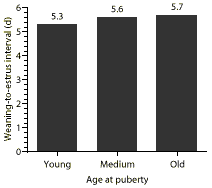v6n4p
What’s your interpretation? |
 The figure opposite shows a relationship between
age at puberty and weaning-to-estrus interval (WEI) of gilts after weaning
their first litter. Average ages at puberty are 185.3, 203.0, and 226.4
days in the young, medium, and old groups, respectively. Sows in the young
group have a shorter (P < 0.05) WEI than those in medium and old
groups. What other reproductive performance can you determine regarding
gilt age at puberty?
The figure opposite shows a relationship between
age at puberty and weaning-to-estrus interval (WEI) of gilts after weaning
their first litter. Average ages at puberty are 185.3, 203.0, and 226.4
days in the young, medium, and old groups, respectively. Sows in the young
group have a shorter (P < 0.05) WEI than those in medium and old
groups. What other reproductive performance can you determine regarding
gilt age at puberty?
Gilt age at puberty and subsequent reproductive performance
Phenomenon
There is a positive relationship between gilt age at first mating or at conception and litter size under commercial conditions. Data presented in Figure 1 were collected from 20 United States swine breeding herds covering a 7-year period from 1986-1992, including 24,056 females. There were 44.4% of gilts with age at first mating between 220 and 240 days. There were 20.2% of gilts with age at first mating younger than 220 days.
There is also a positive relationship between age at the first breeding and culling rate after weaning the first litter (Figure 2), although a large litter is associated with older age at first breeding. The cull rate is largely due to reproductive failure or fertility problems.1
Traditionally, producers preferred to start breeding gilts at an older age, such as the third or fourth observed estrus. In modern swine production, however, many producers decide to breed gilts at a young age (the second estrus or even the first estrus). Since age at puberty has been reduced by genetic selection, one interesting question is whether gilt age at puberty will affect their subsequent reproductive performance.
The figure on the cover demonstrates that gilts with delayed puberty have delayed weaning-to-estrus interval.2 In addition, gilts with delayed puberty have more incidences (P < 0.01) of failing to show standing reflex and ovulation after weaning (Table 1).2 In this study, puberty is defined as the first ovulation. Gilts older than 260 days at puberty were not included. There are no differences (P > 0.05) in age at farrowing and litter size among the three puberty age groups.
In another study conducted by Holder, et al., (1993), litter size at parity 1 tends to be lower (P = 0.1) for gilts selected for early puberty than those with random selection. All gilts were bred at the second estrus in the study. Litter sizes are similar in the two groups for parties 2 through 5. Sows from the early puberty line tend to return to estrus earlier after weaning.
Mechanisms
The frequency of sows in estrus and ovulation within 10 days after weaning is higher in the young age puberty group than the medium and old groups.2 The genetic analysis showed that this relationship is partly genetic. In addition, sows in the medium and old groups have a heavier litter weight gain and larger weight loss during lactation than sows in the young group. The reason for the weight changes is not known.
Implications
Producers cannot breed gilts until they observe estrus of the gilts. Because gilts with delayed puberty have delayed estrus and a high chance failing to show a standing reflex and ovulation after weaning, these gilts should not be chosen for replacement.
References
1 Schukken YH, Buurman J, Huirne RBM, Willemse AH, Vernooy JCM, van den Broek J, Verheijden JHM, 1994. Evaluation of optimal age at first conception in gilts from data collected in commercial swine herds. J Anim Sci. 72:1387-1392
2 Sterning M, Rydhmer L, Eliasson-Selling L, 1998. Relationships between age at puberty and interval from weaning to estrus and between estrus signs at puberty and after first weaning in pigs. J Anim Sci. 76:353-359